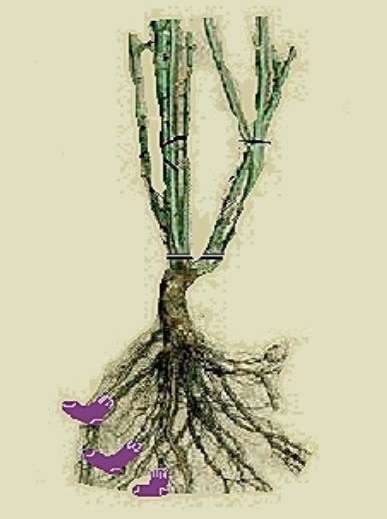With the continually rising popularity of the garden advice programme the organizers decided to offer you a little horticulture this evening. They couldn't afford the fees for my friend Charlie Dimasmuck, so they asked me instead. I'm Alana Titsmuch and I'm here to talk about one particular species, the Osmondium Spectibalis Mulitiflora. As you will know if you are a keen gardener, that means a spectacular plant with numerous flowers. I want to talk about my favourite variety, the king of all fine specimens that you will all want to have in your beds..
the Donnius Osmondium.
Although the Donnius is the dwarf variety of the Osmondium it's still the most stunning to look at. There are several hybrids available, the Teenidolarius that some find a little old-fashioned now, but for some it's still the only Donnius worth having. I prefer the gorgeous Josephus Variagata, a technicolour variety with large, well-developed blooms. If you have a Josephus remember to always keep a sharp set of tools on you because you will want to keep stripping away the outer foliage to reveal the splendours hiding beneath. It is also wise to wear knee-pads to protect yourself, because I do find that there are some jobs easier to do on your knees.
Then there is the Talkus Hostia, which had a brief spell of popularity recently. On the other hand the Little JohnnyJonus was a bit of a disappointment as it bloomed overnight but was gone by the next morning.
The one to really avoid though is the recently developed hybrid, Gamus Showaria Hostia. Heaven knows why this has been developed when so many good varieties of Donnius are already available. It is a gaudy bloom, lacking subtlety and has no place in a tasteful display. Avoid it at all costs.
One last word on the choice of Osmondium. There are other colours available, but don't be deceived. The orange for instance might seem very attractive as a young plant but trust me, in a few years it will lose it's colour and start to look quite tawdry. This never happens to the Donnius. Beware especially of the appearance of any black blooms - they will quickly try to swamp the Donnius given a chance and whatever you do never allow them to seed.
Now, you will need to know how to care for your Donnius once you have selected your variety. I always suggest people start with the very reliable Singerias Talenta. When purchasing your Donnius there are a couple of things to look out for. Check the roots of the young plant, if they have a sort of fluffy purple growth on them then it has purple root-rot which stunts the development of the Donnius for some years and can be very hard indeed to get rid of.
Having selected a strong specimen you need to find it the right position. Donnius only thrive in a prominent position at the front of the border in bright light, showing tendencies to wilt if left in the shade, in fact it almost seems to sulk! It definitely likes plenty of attention, but once you see it displaying its magnificent blooms you'll be very happy to give it that extra TLC.
Keep it moist in warm weather and a handy tip is that this variety actually does better on a good can of cranberry juice than on water alone. If it is very warm cut back as much of the outer foliage as you feel comfortable with. You will both feel the benefit.
In summer particularly watch out for the inevitable parasites and pests, these often appear in large numbers and ruin the view of your Donnius. Spray them liberally with a nasty chemical - it works wonders. Hairspray will do in an emergency.
Last spring a new problem was encountered in the English climate, the Donnius developed 'great and fluffy' blooms which few people found appealing! It is hoped that with some heavy pruning this problem won't re-occur.
Now, a particular nuisance this year has been the Donnius' reluctance to produce the expected Autumn show. Experts have decided that it has obviously been on display too long, due to a long, hot Summer and may, in fact, have only been in a dormant state for 28 days in the last 6 months! Transplant to an Alpine position and don't let anyone see it for at least 3 months. If you are very lucky it may bloom again in spring.
Some people have tried to improve the height of their Donnius by tying it to a tall stake. This doesn't work; you must accept its limitations. However it is an amusing diversion for those dull late-Autumn days.
The Donnius seeds very freely, so propagation isn't a problem. But strangely enough, it only does this about every 7 years, so some patience is required. If you don't want them all over the garden in subsequent years, cross with the Debriflora Glennaria which will ensure only male specimens are produced.
So as we reach the end of the year just remember, before the first frosts, transplant your Donnius to a warm sheltered bed and keep covered till spring. Some people mulch with leaves or straw but the Donnius prefers a large fluffy purple blanket. The thing to remember is that it's important several times during the winter to just climb on in there and check it's all right.
To sum up, if you want a specimen that is wonderful to look at, fun to tend and well worth preparing a winter bed for, get yourself a Donnius.











